We’re all familiar with the Charlottesville chant from two years ago: Jews Will Not Replace Us.
It’s a perennial paradox. Torch-bearing worshippers of an almighty God, who answers prayers with miracles, and devotion with salvation, at the same time have an inferiority complex as vast as their numbers. In 2014 the Pew Research Center’s Religious Landscape Study reported that if the U.S. had a population of only 100 (adults) there would be two Jews, one Muslim, and 71 Christians. Verily: Jews will not replace Christians. But what might rightly rile these folks are two other Pew stats: 1) only 47 of those 71 nominal Christians are white and 2) as many young people identify as “unaffiliated” as they do “Protestant.” (Earlier I discussed how sex surveys of young people show that about 1 in 5 don’t ID as straight—about the same percentage as the unaffiliated total in the Pew poll.)
KKKpleton
When my wife Andrea Carney and I first moved to our Denver neighborhood in 2005, Andrea found it was named for a mayor who had profited politically from the prototype of what we saw in Charlottesville. We were heartened in 2015 when Black Lives Matter began an effort to change the name.
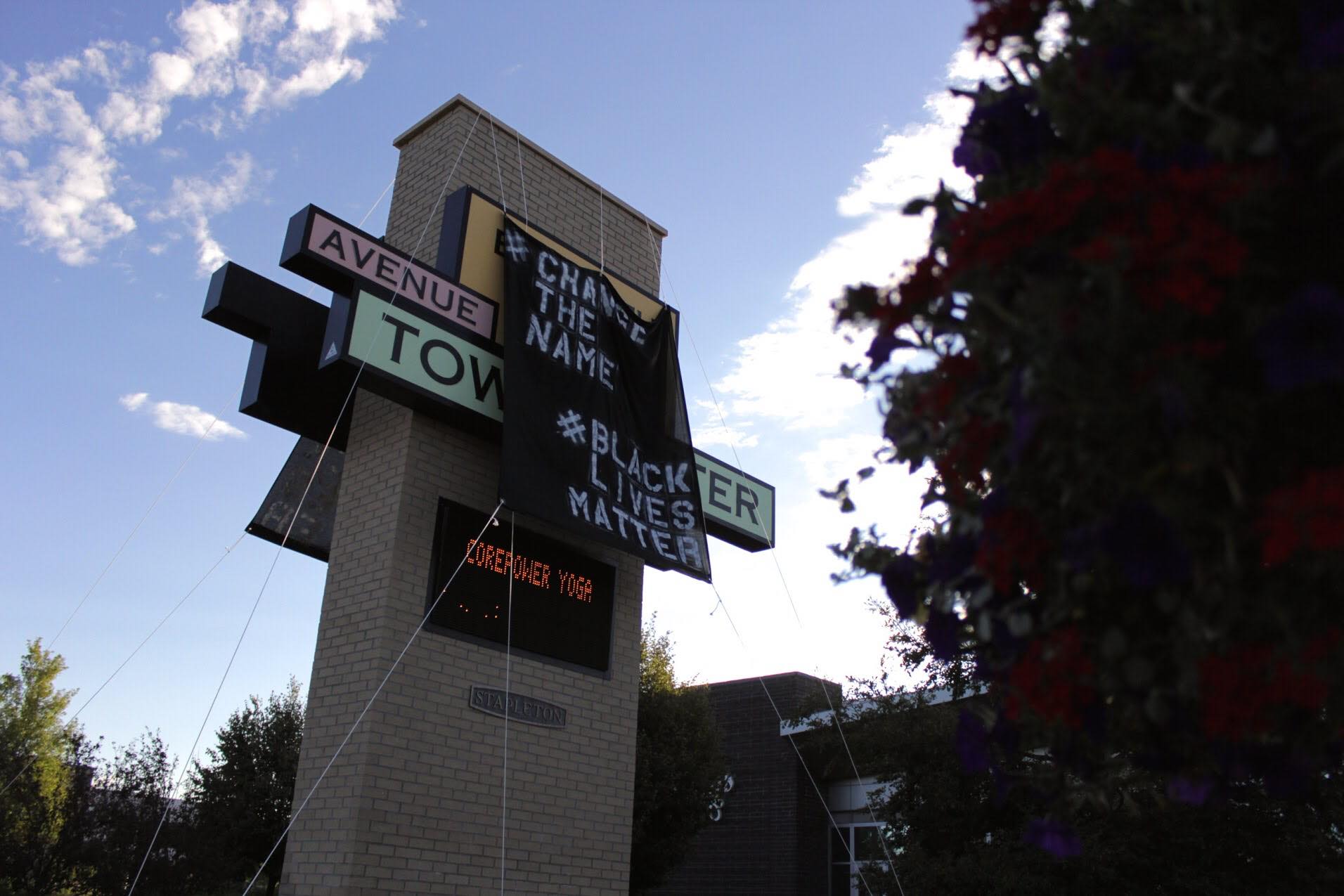
In July of this year, we and our neighbors (property owners only, no renters) voted whether to retain the neighborhood name Stapleton, which we inherited from the former airport on which our plots are platted. (Our true legacy, of course, is from indigenous people, as explained here.)
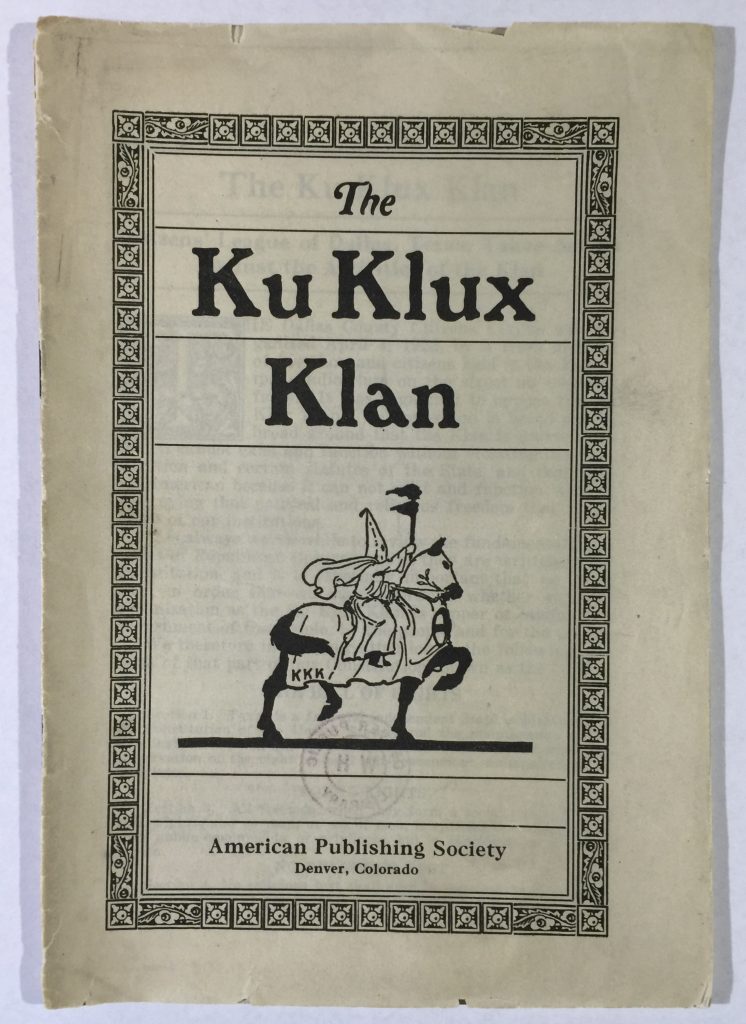
Benjamin Stapleton, mayor here for twenty years in the 1920s, ’30s, and ’40s, was a member of the Ku Klux Klan, a factoid that’s been overshadowed by, well, the airport he championed, the completion of our civic center under his watch, and an expansion of our parks—including Red Rocks with its famous amphitheater. We were unsuccessful in convincing our neighbors to remove the name via the vote, results of which were announced on August 19: 35% for removal, 65% for retain. A day later, Ben’s great grandson, Walker Stapleton,1 made the following comments:
Well, I’ve always said, as the treasurer of Colorado and as a candidate for governor, that I thought this was a community decision. […] It’s important when we’re all looking back in history a hundred years to take full measure of somebody’s life and contributions. Because if you’re looking for a closet filled with white linen a hundred years back in people’s family tree you’re gonna be looking far and wide.
I’m compelled to remark that Ben Stapleton’s closet did not want for white linen.
Because nobody’s perfect; everybody makes mistakes. It’s inexcusable that he joined that organization which, you know, espouses abhorrent points of view. But I think we need to focus more on what brings us together as a community and not what divides us. […] He built the first airport and the City and County Building2 and the entire park system for the city of Denver, which exists to this day including Red Rocks.3
Ben Stapleton’s “mistakes” endured throughout his career. They began with his induction into the KKK, member No. 1,128, and continued with his first campaign for mayor in 1923, as chronicled by historian Robert Goldberg in his book Hooded Empire: The Ku Klux Klan in Colorado.4 During that 1923 campaign, while Stapleton was supported behind the scenes by the KKK, he uttered his most famous lines, as recorded in the Denver Post just twelve days before his election as mayor.
True Americanism needs no mask or disguise. Any attempt to stir up racial prejudices or religious intolerance is contrary to our constitution and therefore un-American.5
Today these words have become a trope in discussions of Stapleton’s legacy, recited at community meetings and recounted by the media. They supposedly are an indication of his repentance. They were in fact themselves a mask—a smokescreen to placate Jewish and Catholic voters who might have heard rumors of Ben’s Klan konnection but who otherwise embraced the Democrat’s (!) platform: “pledging a war on crime and vice, lower taxes, and an efficient and frugal city government.”6
Clearing the Smoke
In March 2016, citing the “True Americanism” quote of the 1923 election, I asked Prof. Goldberg about Stapleton’s ostensible change of heart. “I do not recall any time that he ever voiced contrition publicly,” he told me.
While Goldberg writes that Stapleton was a “close friend” of John Galen Locke, Grand Dragon of the Colorado Klan,7 he does not note the fact that Locke was the mayor’s campaign manager the next year during Stapleton’s recall. All smoke had cleared by that election day, as evidenced by the Post’s coverage, below, under its front-page headline on Wednesday, August 13, 1924: Stapleton Wins by 31,000.
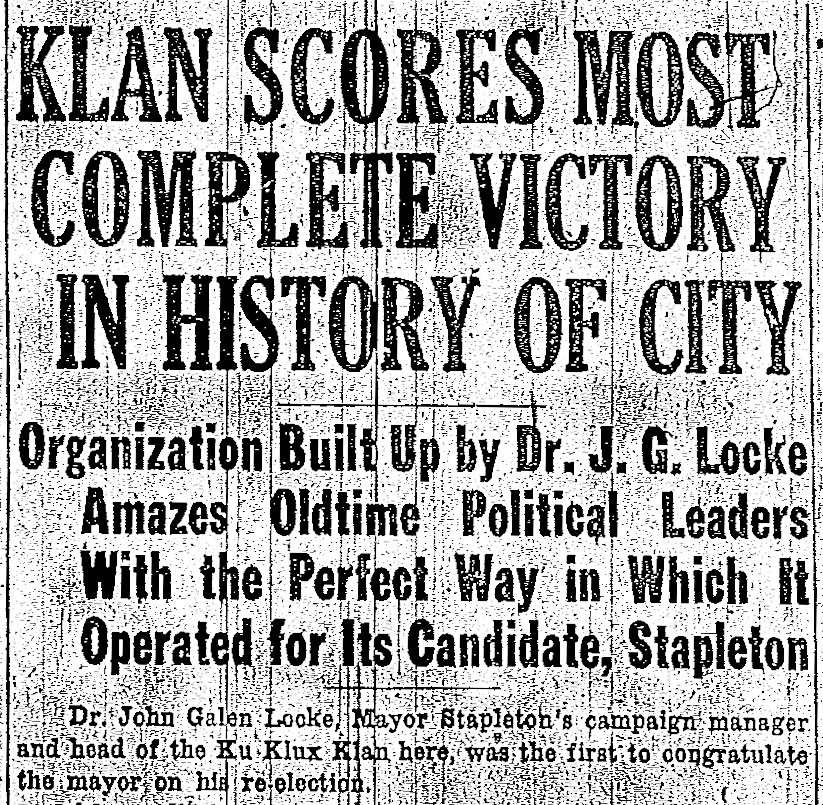
And there had been no need for smokescreens during the campaign either. “In the flickering light cast by the flaming cross,” a month before the recall vote, “Klansman Benjamin F. Stapleton gave his pledge to wearers of the pillowcase and sheet to do the will of the Klan in Denver if he is re-elected mayor,” the Post reported.8
Continuing…
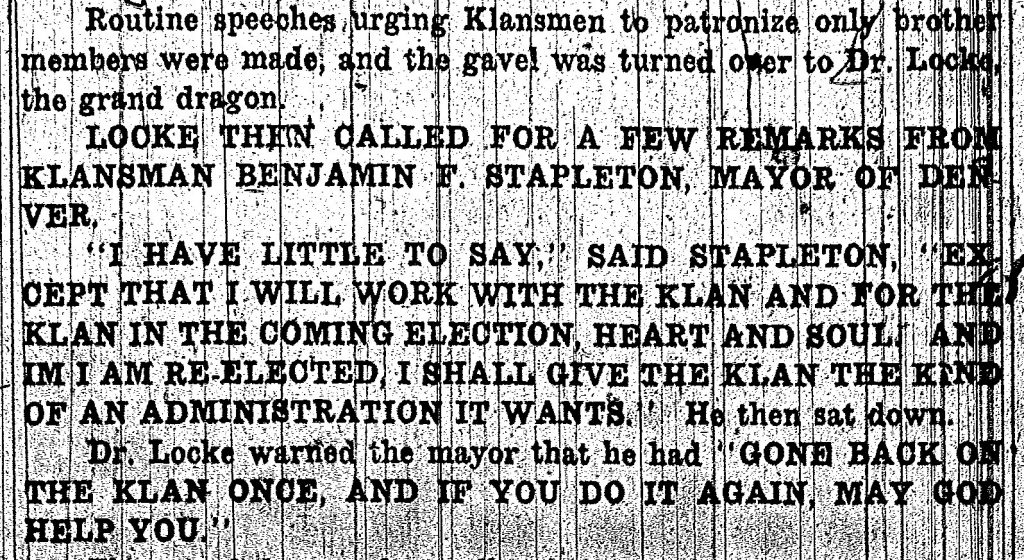
The eloquence of Stapleton and Locke was surpassed, however, by that of the mayor’s choice for police chief (quoted below). Ironically it had been Stapleton’s prior foot-dragging before finally appointing a Locke “lieutenant” to the top-cop post that had caused the Grand Dragon to launch a recall petition. It got out of hand, however, when others thought that removing Stapleton—and his Klan kronies—wasn’t such a bad idea. After all, Chief William Candlish had no police experience, and once installed, he eagerly gave favors to cops who joined the Klan.9 But I digress.

This language, from that July 14, 1924 cross-burning, wasn’t reported in the Denver press until just a week before the August 12 recall vote. For every anti-Klan voter it might have roused, two pro-’s could have been propelled. As the subheadline above infers, the recall drew the largest turnout in Denver’s history, with Stapleton garnering a greater than 2-to-1 victory over his opponent. Only in Jewish precincts along West Colfax did the recall do well.10 The Invisible Empire—a Klan self-referential term—had revealed its relevance.
Breaking Up Is Hard to Do
The following April of 1925, Stapleton humiliated his police chief by conducting what became known as the Good Friday vice raids—behind Candlish’s back.11 On June 30 the Klan voted to banish Stapleton from its ranks—along with none other than U.S. Senator Rice Means, Colorado Secretary of State Carl Milliken, and six of the mayor’s kronies in city hall.12 Two weeks later, on July 15, Stapleton “declared his independence” from the Klan, as Goldberg puts it, by firing Candlish.13
Despite having broken with John Locke and the Klan, Stapleton’s civic stewardship doesn’t appear to have veered from the Klan agenda. “Neither he nor the Klan seemed to mellow over the years […],” write academics Richard Delgado and Jean Stefancic in their 1999 study of racism in Colorado higher eduction.14 Citing a historical retrospective issued by Colorado’s department of education, the authors outline practices (outside the mayor’s immediate purview) such as recording the race and religion of public school teachers and of students in state colleges and the University of Colorado that allowed the screening out of “undesirables.” And discrimination in housing was fine-tuned against Jews, Catholics, Native Americans, African Americans, and Asian Americans.15 Stapleton apparently had priorities other than equity in housing.
Prejudice against Mexicans and Mexican Americans also was so rampant that it led the Mexican government to refuse to allow its guest workers (braceros) into the entire state of Colorado, on the one hand,16 and led to the emergence of the Denver Unity Council on the other—where “the Japanese, the Jew, the Negro, and the Spanish-speaking American listen to one another’s complaints,” as described by the NAACP.17 In 1946 the Unity Council issued a major but flawed report, The Spanish-Speaking Population of Denver: Housing, Employment, Health, Recreation, Education, “in cooperation with thirty-two local, state, and federal organizations.” Flaws and all, the report still was an indictment of a system of degradation, stating “that the cycle of poverty in which the community is trapped is apt to be trans-generational and self-perpetuating,” as described by Delgado and Stefancic.18
Both that system of degradation and Ben Stapleton were challenged the next year by a man half his age, attorney J. Quigg Newton, whose mayoral campaign pledge to create a human relations task force was realized upon the incumbent’s 1947 defeat. What would eventually become known as the Denver Commission on Human Relations performed its own investigation that same year. The result was a Unity Council study on steroids: A Report on Minorities in Denver.19
The tenor of the report is suggested by Delgado and Stefancic’s summaries of four instances of brutality on the part of the Denver police: a Latino boy losing two front teeth for daring to inquire about work at the back door of a well-known restaurant; a Latino beaten with blackjacks for awaiting service at another restaurant, with protesting patrons jailed; two Mexican nationals, waiting for a cab upon their release from a hospital, thrown in jail, incommunicado, for seventy-two hours; a Latino, charged with resisting arrest, succumbing to his injuries, including a brain hemorrhage.20 The Report on Minorities also documented the snubbing of Jews who sidestepped restrictive housing covenants via “second sale” home purchases (selling once to a non-Jew, then again to a Jew), per historian Michael Adam Lee.
Two Jewish families that did this almost immediately sold their properties due to what the Mayor’s Interim Survey Committee on Human Relations in 1947 identified as “social exclusion.” This took the form of snubbing and forbidding Jewish children from playing with non-Jewish children. Jews who managed to get into these restricted neighborhoods were treated as pariahs and chased out.21

Sibling Cities
When I read about this post-war/post-Stapleton soul searching—this overhaul by the tame tag of “human relations”—I was reminded that the very same approach took place in Minneapolis, the city Carey McWilliams had called, in 1946, “the capitol [sic] of anti-Semitism in the United States.”22 After McWilliams (who would become editor of The Nation magazine in 1955) wrote these words they were appropriated by a Minneapolis neo-Nazi group, which posted signs on the University of Minnesota campus: “When they start talking racial equality, pull the safety catch on your gun,” and “Hail to Minneapolis, capital of anti-Semitism.”23
Minneapolis mayor Hubert Humphrey had conducted his own version of Ben Stapleton’s Good Friday vice raids twenty years later, in the summer of 1945.24 And just as Denver mayor Newton did in 1947, Humphrey had established the Mayor’s Council on Human Relations the year before in Minneapolis. Humphrey even rammed a fair employment practices ordinance through his city council in early 1947.25 Newton tried something similar, but left the decision up to the citizenry. Newton
constituted a charter convention to propose laws against racial discrimination in hiring and a civilian review board to investigate complaints against the police. Inflamed by the draft charter’s pledge committing the city to fair employment regardless of color, creed, or religion, city voters emphatically rejected the document.26
Newton doesn’t appear to have challenged restrictive covenants in housing; it remained for the U.S. Supreme Court to strike down their enforcement in 1948.
Less than a year before that SCOTUS decision, Humphrey had received notice of a remarkable instance of home ownership discrimination against Jews—as wretched as the “second sale” cases reported by Denver’s human relations commission. A Mrs. Phillip (Bess) Hoffman wrote Humphrey that her earnest money on a property in St. Louis Park,27 two blocks west of the Minneapolis city line, had been returned in June 1946. “We were told that it is the policy of the [realtor] not to sell a home to a Jewish family unless there already was a Jewish family in that block.” When word of the impending sale got around to the neighbors they threatened to boycott the realtor’s firm, as the realtor conveyed in his reply to Humphrey:
I have publicly stated my position regarding discrimination and our company’s policy was no different then than it is now, which expresses my policy, but much of our business comes from this area in St. Louis Park and we could do nothing for business reasons but conform to the demands of the people living in that immediate neighborhood, as much as our sympathies might be with the Hoffmans and our desire to help them.
The realtor happened to be Charles E. Spring, president of the Minneapolis Board of Realtors.28
Later that summer of 1946 Humphrey’s Council on Human Relations obtained city council endorsement of a timid request that the Board of Realtors “eliminate restrictive covenants in new subdivisions.”29 That request, however, contradicted the Board’s own Code of Ethics, as explained by Charles Spring to the Mayor’s Council eleven months later, on July 14, 1947. Spring stated that the Code explicitly “provides that no realtor should introduce into a neighborhood any buyer or occupant who would be detrimental to property values” and that the Board only then was considering its elimination. He “stated that the members of no minority group, by their own actions, destroy property values” but rather “it is the attitudes of prejudice on the part of other property owners and prospective buyers” that may do so. He suggested that legislating away restrictive covenants would take the heat off of realtors.30 Again, this was made moot nine months later when the Supreme Court struck down enforcement of restrictive covenants, in Shelley v. Kramer, on May 3, 1948.
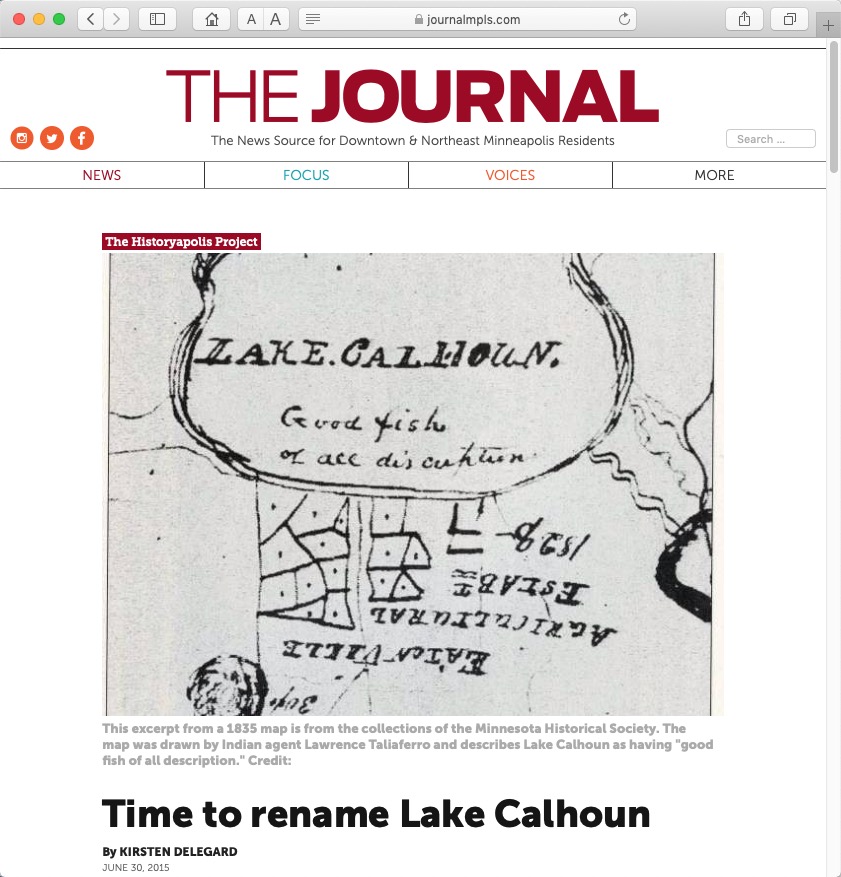
An Invisible Empire
In my own neighborhood—named after Benjamin Franklin Stapleton, a politician whose career was launched and sustained by the Ku Klux Klan and its benefaction—the delegates to our Stapleton Master Community Association, despite their personal feelings on the matter of a name change, have claimed to be constrained by their constituents. Now the recent vote by us property owners provides ample rationale to maintain the status quo. Just as in Minneapolis, realtor Charles Spring was constrained by his clients. Just as in Denver, Mayor J. Quigg Newton’s constituents voted to turn down efforts to deal with discrimination in hiring and police brutality.
The first definition of the term setback has two meanings in relation to progress: a reversal or a check. I prefer the second.
Header image: letter in the
KKK collection of the
Denver Public Library,
Western History/
Genealogy Department
Notes
- I’m reminded by my wife Andrea Carney that Walker’s, mm…, Christian name comes from his mother’s side. Dorothy Walker Stapleton is first cousin to George Herbert Walker Bush.
- Walker Stapleton fudges a bit here because the Civic Center project was initiated by Mayor Robert Speer (1904–1912, 1916–1918), with the City and County Building envisioned since 1907. Ben Stapleton saw that building to near completion but did so without a construction bond. He also did so without a bidding process by a much-lauded group of architects that had incorporated illegally, which was contested (successfully) up to the State Supreme Court. Meanwhile Stapleton himself was contested on the 1931 mayoral ballot, which did include a construction bond measure. The measure won, Stapleton did not, and the City and County Building was completed by his successor, dedicated on Colorado Day, 01 Aug 1932. (George V. Kelly, The Old Gray Mayors of Denver, Boulder: Pruett Publishing, 1974, 4–6)
- Walker Stapleton fudges here again. Ben Stapleton did not build “the entire park system for the city of Denver.” The Denver Mountain Parks system was begun under Mayor Robert Speer (1904–1912, 1916–1918) according to the system’s Wikipedia entry.
- Robert Alan Goldberg. 1981. Hooded Empire: The Ku Klux Klan in Colorado, Chicago: University of Illinois Press, 1981, 30.)
- “Stapleton Platform Raps Race Prejudice Agitation, Warns Usurpers of Law,” Denver Post, 03 May 1923.
- Goldberg, 29.
- Goldberg, 30, 15.
- “Stapleton Promises Klans They Can Have Anything They Want,” Denver Post, 08 Aug 1924, 23. Both the Post and the Denver Express did not report on the July 14 cross-burning until early August.
- Goldberg, 32–33.
- Goldberg, 34. These statistics are covered by several articles in The Denver Post, 13 Aug 1924.
- Goldberg, 99.
- Goldberg, 106.
- Goldberg, 107.
- Richard Delgado and Jean Stefancic, Home-Grown Racism: Colorado’s Historic Embrace—and Denial—of Equal Opportunity in Higher Education, University of Colorado Law Review, Vol. 70 (1999), No. 3, 736; archived here.
- Delgado, 736. See James A. Atkins, Human Relations in Colorado: A Historical Record, Colorado State Department of Education, 1968.
- Delgado, 745.
- Mark Hanna Watkins, “Racial Situation in Denver,” The Crisis, May 1945, 140; archived here.
- Delgado, 745. The authors write (n298) that the Council report was the result of a “survey and analysis” by local pollsters but drew on existing faulty data “instead of interviewing members of the community.” Despite another flaw it “became the model for subsequent investigations” including the one described immediately below.
- Delgado, 738 n257, 746, 747. Delgado and Stefancic’s lengthy praise for the report, from its participants to its methodology, is outlined on 746.
- Delgado, 748. Police brutality against Mexican Americans was an issue with which homosexuals in Los Angeles found common ground. See my “1952: A Triad” for the story.
- Michael Adam Lee, The Politics of Antisemitism in Denver, Colorado, 1898–1984, History Graduate Theses & Dissertations No. 37 (2017), 127.
- Carey McWilliams, “Minneapolis: The Curious Twin,” Common Ground, Autumn 1946, 61; archived here).
- “U Skeptical on Theory of Campus D[emocratic] N[ationalist] P[arty] Group,” Minnesota Daily, 08 Jan 1947.
- Gary W. Reichard, “Mayor Hubert H. Humphrey,” Minnesota History, Summer 1998, 55–56; archived here.
- Reichard, 62.
- Delgado, 747; no date for the effort is given. See also Dani R. Newsum, Cold War Colorado: Civil Rights Liberals and the Movement for Legislative Equality, 1945–1959, M.A. thesis (2012; archived here), 27: “The Unity Council’s legislative committee spearheaded three pioneering campaigns for state-wide fair employment legislation in 1945, 1947, and 1949. Although those efforts were unsuccessful, the Council’s work laid the organizational and philosophical foundation for the more fruitful legislative campaigns of the 1950s.”
- George Floyd, who was killed by Minneapolis police on Memorial Day 2020, was a resident of St. Louis Park.
- References available upon request.
- “Council Rejects Valuation Hike,” Minneapolis Morning Tribune, 10 Aug 1946, 7.
- Reference available upon request.

